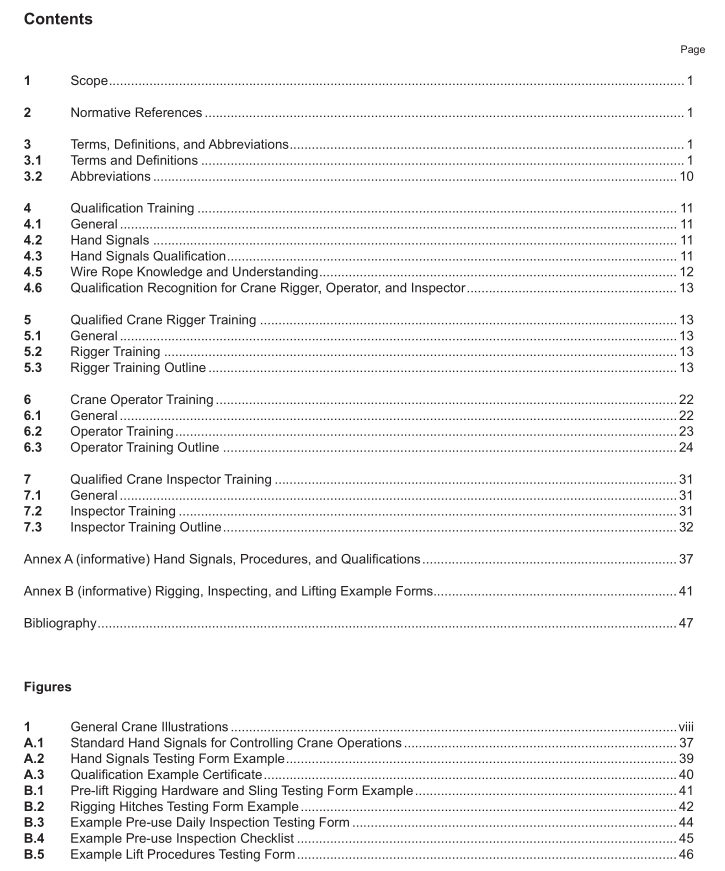API 2D-2 pdf download

API 2D-2 pdf download Training for Ofshore Pedestal- Mounted Crane Riggers, Operators, and Inspectors
4Qualification Training
4.1General
Training requirements in this standard include the following:a)qualified crane rigger training (Section 5),
b)qualified crane operator training (Section 6). andc)qualified crane inspector training (Section 7).
Also included are requirements for qualification in the use of hand signals to complement each of the three cranequalification types in accordance with this standard. lt is intended that the training be sequential, i.e. rigger issuccessfully accomplished before proceeding to operator and that operator is successfully accomplished beforeproceeding to inspector.
Instructors who teach either crane rigger, operator, or inspection training shall have applicable field experience inoffshore lifting and rigging operations and have successfully completed a train-the-trainer course.
4.2Hand Signals
Recommended standard hand signals are identified inAnnex A,Figure A.1.The figures have been supplementedwith hand signals for articulating boom cranes. For articulating boom cranes, some of the hand signals/handmovements may be the same as for a mechanical or telescoping boom crane but the intended action is slightlydifferent, these are noted in the figures. If articulating boom cranes is not mentioned, it means that the handsignal is universal to all cranes.The use of these recommended standard hand signals is encouraged.
4.3 Hand Signals Qualification
The objective of the hand signal task is to test the student’s ability to understand and perform the basic handsignals in this standard for the purposes of API 2D. The examiner shall use the appropriate hand signal to thecrane configuration (e.g. telescoping, folding (knuckle) boom crane,etc.).
The testing of hand signal proficiency shall include the following.
a) The designated signal person shall have the opportunity at the start of this task, to discuss any special hand
signals.
b)Verify hand signal chart is posted.)At the examiner’s indication to start.
d)The student shall be asked to respond and/or describe verbally five or more of the standard hand signals inthis document.
e) The examiner may give the hand signal request in any sequence.Then the student shall perform the signal
for the following (for additional hand signals, see AnnexA,FigureA.1 and API 2D section for Special Signals) :
1) hoist,
2) lower,
3 dog everything.4) emergency stop,
5) raise boom,6) lower boom,
7) swing as directed (e.g. left or right direction), and8 move slowly.
At the examiners indication the task is concluded.The examiner shall review the test results of the practical andensure the student has an acceptable understanding.
The examiner and student shall sign the practical exercise form.The student signing the practical exercise formvalidates they have an acceptable understanding and knows their responsibilities.
4.5wire Rope Knowledge and Understanding
4.5.1Objectives
The objective is to test the student’s understanding and demonstrate the appropriate knowledge needed for thisstandard and the purposes of API 2D. The skills and knowledge needed to apply the industrial standards andrequirements for examination or removal of wire rope in service, or both.
a) A thorough understanding of wire rope construction and its:
1) construction effects on performance and applications, and2construction factors causing rope deterioration.
b) A thorough knowledge of safe use and handling of wire rope in accordance with their operations and therequirements of the health and safety legislation.
4.5.2 Practical Evaluation
The testing of wire rope knowledge and understanding shall include the following:a)inspection responsibility,
b) manufacturing (an introduction to the manufacturing process and testing).c)rope terminology.
1) terms and definitions,2y types and construction.
i) Information on the different types of rope available,ii)Classes, designation, and characteristics of wire rope,
ii) Lay length (i.e. right regular lay, left regular lay, rotation resistant),
d) a practical assessment of steel wire rope characteristics that includes an appreciation of rope strength.
flexibility, fatigue, wear, abrasion, rotation, and elongation,
e) rope deterioration including rope terminations/end fittings, good, bad, and indifferent,f)inspection/examination procedures,









